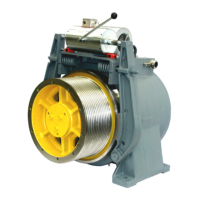OPERATING MANUAL DAF380 MAINTENANCE/SERVICE
ThyssenKrupp Aufzugswerke GmbH
7.10 Emergency measure "Releasing the car from the engaged position
(safety gear)"
If the safety gear on the elevator car or counterweight has triggered, it can
occur that the driving force of the traction sheave is insufficient to move the
elevator; the ropes slip through.
Perform the following measures in this case:
• Switch off the drive and control system.
• Remove the traction sheave cover above the traction sheave.
• Release the hydraulic jack on the pull side of the traction sheave and
place it in the mounting borehole in the machine base frame.
• Screw the pressure arm with centring pin facing downwards onto the
front of the traction sheave. Here, use the thread near the jack (see Fig.
7.10.1).
• Engage the blocking clamp with lug in the ring groove under the brake
disc and bolt in the next thread above the pressure arm on the traction
sheave (see Fig. 7.10.1).
• Tighten the 3 pressure screws to clamp the ropes with the pressure
piece.
• Operate the release lever on the brake magnet and pump the jack to
move the traction sheave in the desired direction until the safety gear
lock is released. (The drain valve must be closed; the centring pin of the
pressure arm must be located in the groove of the jack).
• After the pulling operation has been completed, remove the blocking
clamp and mount the rope fixing beam as well as the traction sheave
cover according to instructions.
Mounting the blocking clamp
Note: If the hydraulic jack travel or the traction sheave movement is not
enough to free the elevator car, secure it by applying the rope clamp. The
rope clamp must then abut with the recess on the machine base frame, the
other side of the rope clamp on the flat bar welded to the inside of the base
frame.
Fig. 7.10.1
1 Lug
2
Pressure piece
3
Pressure screws
3

